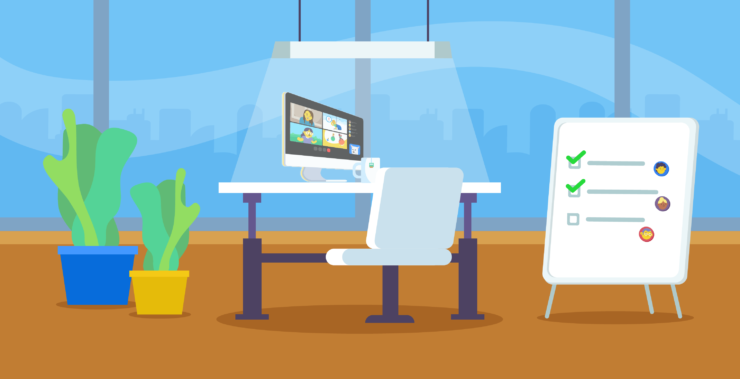Our environment has an impact on us mentally and physically. We can also say that this has major implications for our productive and creative days.
The majority of us may work in environments that might sacrifice comfort, function, and livability — but without these aspects, it’s difficult to focus and invest your energy. The more comfortable and positive the surrounding vibe is, the more creative and efficient you will be.
Regardless of whether you work remotely or in-office, maintaining an ideal work environment is essential to the success of your organization and professional goals.
Any successful business relies on a cohesive workforce that can produce maximum outcomes and high levels of productivity. A company’s productivity, and excellence all increase when you have an ideal work environment – this is because it produces higher-quality solutions.
You must take the necessary actions to provide a perfect working environment for both you and your employees if your goal is to expand your business in the long run.
What is an ideal work environment?
The ideal work environment is a perfect constellation of physical space, workplace culture, and processes that all contribute to employee success. It is more than a sunlit room or a nice cushioned seat; it is a place where people feel free, valued, and ready to do their best at work. Such an environment encourages not only activity, but also creativity, new ideas, and long-term commitment to the work.
Firstly, an ideal working environment is based on the central tenet of balance between the individual and the group. It ensures that everyone has what they need to do their job, including tools, resources, and time. It is also a higher level of existence where interactions are supportive, respectful, and peaceful, making it easier to achieve individual and organizational goals.
Achieving this balance is not an accident. Organizations should think about creating engaging spaces, fostering a sense of community, and developing practices that motivate leaders. From this foundation, concepts can be built for a thriving workplace for people and the organization.
Here are some practical steps you can take to create the perfect work environment.
Tip # 1: First things first, have a comfortable office
A neat, stylish office can make a big difference in the interaction between employees and managers. Even if your office doesn’t get sunlight, try to create a light environment with comfortable furniture. An ergonomic environment with adjustable chairs and desks will prevent physical strain and help you focus throughout the day. Natural light or even well-placed artificial lighting can also improve mood and energy levels.
Give employees the option to work wherever they feel most comfortable in the office. Make it simple for them to purchase items on the business dime, such as exercise balls and plants. These small additions can create a more dynamic and inviting workspace that can help reduce stress and foster creativity. In particular, greenery has been proven to improve air quality and create a calming atmosphere.
Allowing employees to personalize their desks is also important, so they feel valued and at ease in the workspace. Let them bring in things like family photos, motivational quotes, or small decorations that reflect their personality. This personalized approach will help them feel at home and bring a bit of joy and connection to their daily work life.
Tip # 2: Strike a balance between predictability and flexibility
It’s crucial to strike a balance between predictability and flexibility when developing the ideal work environment for your company and employees.
With the advent of the work-from-home option, it is now possible to integrate routine duties into the 9 am till 5 pm workday. But the extra flexibility has a price.
In order to collaborate and complete tasks in teams in a flexible yet ideal work environment, additional preparation and collaboration are needed. It is far more challenging to predict who will be in the office on particular days.
How can flexibility and predictability be balanced? To let your team see your actions, schedule your workday in Outlook Calendar.
If you spend most of your time in the office, schedule certain days for focused work or a face-to-face catch-up (if you are mainly working remotely). Utilize resources like displays or dashboards to visualize availability.
Tip # 3: Focus on a solid leadership style
Productivity and morale are utterly destroyed while working for a bad or ineffective supervisor. This is why the main element in creating the ideal work environment is having the correct leadership traits in place to motivate your employees.
Regardless of how small the team is, someone will unavoidably need to serve as the group’s leader as they collaborate.
A leadership team should have a solid work ethic, a clear sense of strategy, and excellent management techniques since these traits produce an ideal work environment much more quickly than those of a team without them.
Irrespective of who you decide to have in charge of your team, ensure they foster camaraderie and guide everyone toward a single objective.
Tip # 4: Have an effective communication system
In an ideal work environment, verbal communication and nonverbal message are essential both between employers and employees and inside the workforce. Employees usually have to convey the organization’s values, objectives, goals, and other important information for which effective communication is essential.
Employees also anticipate that management will be open and honest about the company’s objectives. This two-way communication promotes a positive and ideal work environment and creates trust.
Emails, company-wide memos, and in-person meetings are just a few examples of the various ways that people might communicate.
Active listening is another crucial component of communication that works. Companies can establish a more pleasant work atmosphere when they pay attention to the concerns of their employees.
Employee performance can be improved through connecting with an organization’s values, participating in its strategy, and giving their ideas and thoughts through a listening culture. Building a stronger team and more effective workflows depends on effective communication competence.
Tip # 5: Focus on a strong organizational culture for an ideal work environment
The culture of a company plays a crucial role in creating an ideal work environment. An organization’s bottom line may be impacted by having a good business culture because employee engagement is closely correlated with culture.
Unfortunately, some businesses have a more formal, conventional culture that requires employees to dress professionally and adhere to tougher rules.
Other workplace cultures are easier, permit employees to dress more informally, and even give them greater latitude in how they carry out jobs. A major contributor to creating comfort in the workplace is how a firm views the world and how its objectives match those of its people.
Tip # 6: Carry out regular team sessions
You can set aside a quarter hour for a team conversation to get your day off to a good start. Make sure to address the day’s objective in this conversation and find solutions to the problems from the previous day.
You can promote interdepartmental collaboration on various projects and let them complement and counsel one another. It is crucial that you mentor any new hires or interns at your organization throughout.
Your team will probably start the day with greater enthusiasm and passion if you do it this way. It would be prudent to avoid beginning the day with any kind of negativity because it will have an impact on the entire team throughout the day.
Tip # 7: Express gratitude and recognize efforts
Consistently expressing gratitude to employees serves as a powerful incentive. They are inspired to work harder and set greater goals when they are aware that the work they perform is respected and valued.
Be sincere in your acknowledgment, and keep in mind that emotions are contagious. Your employees will pick up on your graciousness and positivity as they interact with one another and with customers.
Employees will become resentful if you have a pessimistic attitude and don’t acknowledge accomplishments, your top workers will start to go elsewhere.
They seek to understand the value of their time and efforts, as well as their worth and respect. Ensure that you always express sincere gratitude.
Why is an ideal work environment important?
Creating an ideal work environment inspires and encourages your employees, which increases employee satisfaction and loyalty inside your company. When workers are appreciated and free in their respective working environments, they tend to be committed, motivated and take responsibility for their job more.
Your employees will be less stressed at work and more likely to contribute ideas for your business’ success, which will help it expand and flourish. A supportive atmosphere decreases stress levels and promotes a feeling of positive health, helping employees to concentrate on their duties without fret over workplace problems.
An ideal work environment can increase output, lower absenteeism, and, in some industries, lower workers’ compensation and health insurance claims. On top of that, it helps attract and keep top talent, so your company has a solid, loyal team ready to drive growth.
Ending note
Think for a moment about your ideal work environment. Imagine a place where employees not only feel comfortable but also inspired to be their best selves. A place of work that encourages employee engagement fosters development at all organizational levels and fosters a welcoming environment for all team members. It’s an environment where each person’s contribution is valued and nurtured, helping them grow both professionally and personally.
Ваша рабочая среда оказывает значительное влияние на ваш успех и счастье. Исследования постоянно показывают, что когда сотрудники окружены позитивными, мотивирующими и комфортными пространствами, их производительность и удовлетворенность работой резко возрастают. С другой стороны, скучная или негативная рабочая среда может истощать энергию и креативность сотрудников, в конечном итоге влияя на их производительность и моральный дух.
It can take a toll on your mental and physical health if you’re not enjoying being in an ideal work environment. A lack of comfort, poor communication, or a stifling culture can lead to stress and burnout, which impact your overall well-being. Creating the right environment is key to fostering both personal satisfaction and organizational success.
So what is your ideal work environment? Share your thoughts and experiences with us!









Add comment